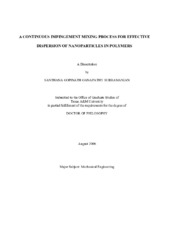| dc.contributor.advisor | Andrews, Malcolm J | |
| dc.creator | Ganapathy Subramanian, Santhana Gopinath | |
| dc.date.accessioned | 2006-10-30T23:29:33Z | |
| dc.date.available | 2006-10-30T23:29:33Z | |
| dc.date.created | 2006-08 | |
| dc.date.issued | 2006-10-30 | |
| dc.identifier.uri | https://hdl.handle.net/1969.1/4320 | |
| dc.description.abstract | Mixing refers to any process that increases the uniformity of composition and is
an integral part of polymer processing. The effective mixing of nanoparticles into
polymers continues to be one of the leading problems that limit large scale production of
polymer nanocomposites. Impingement mixing is a novel, relatively simple, continuous
flow mixing process wherein mixing is accomplished by immersing a high velocity jet in
a slower co-flowing stream. The resulting recirculating flow produces an energy cascade
that provides a wide range of length scales for efficient mixing. An impingement mixing
process was developed and studied through experiments and simulations. Numerical
simulations were conducted using FLUENT to understand better the mechanism of
operation of the mixer. The formation of a recirculation zone was found to affect the
dispersion of nanoparticles. Results of the simulations were compared with experimental
data obtained under similar conditions. While this process may be used for any polymernanoparticle
combination, the primary focus of this study was the dispersion of Single
Walled Carbon Nanotubes (SWNTs) in an epoxy matrix. The dispersion of SWNTs was evaluated by analyzing SEM images of the composites. The image analysis technique
used the concept of Shannon Entropy to obtain an index of dispersion that was
representative of the degree of mixing. This method of obtaining a dispersion index can
be applied to any image analysis technique in which the two components that make up
the mixture can be clearly distinguished. The mixing process was also used to disperse
SWNTs into a limited number of other polymers. The mixing process is an "enabling"
process that may be employed for virtually any polymer-nanoparticle combination. This
mixing process was shown to be an effective and efficient means of quickly dispersing
nanoparticles in polymers. | en |
| dc.format.extent | 8400109 bytes | en |
| dc.format.medium | electronic | en |
| dc.format.mimetype | application/pdf | |
| dc.language.iso | en_US | |
| dc.publisher | Texas A&M University | |
| dc.subject | nanoparticles | en |
| dc.subject | polymers | en |
| dc.subject | impingement mixing | en |
| dc.subject | carbon nanotubes | en |
| dc.title | A continuous impingement mixing process for effective dispersion of nanoparticles in polymers | en |
| dc.type | Book | en |
| dc.type | Thesis | en |
| thesis.degree.department | Mechanical Engineering | en |
| thesis.degree.discipline | Mechanical Engineering | en |
| thesis.degree.grantor | Texas A&M University | en |
| thesis.degree.name | Doctor of Philosophy | en |
| thesis.degree.level | Doctoral | en |
| dc.contributor.committeeMember | Grunlan, Jaime C. | |
| dc.contributor.committeeMember | Morgan, Roger J. | |
| dc.contributor.committeeMember | Rediniotis, Othon K. | |
| dc.type.genre | Electronic Dissertation | en |
| dc.type.material | text | en |
| dc.format.digitalOrigin | born digital | en |


